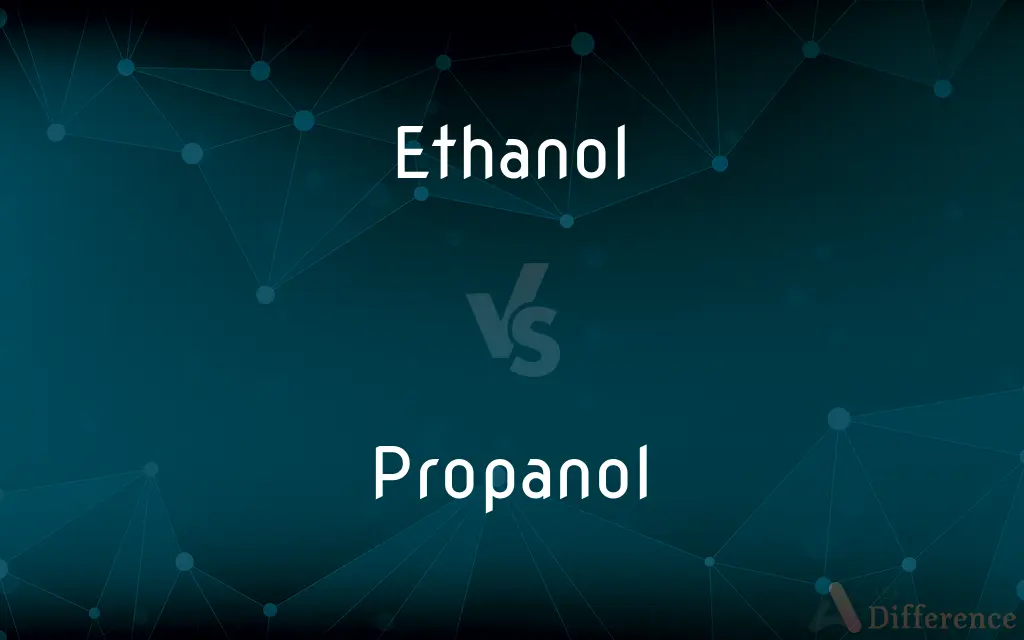Ethanol vs. Propanol — What's the Difference?
Edited by Tayyaba Rehman — By Fiza Rafique — Updated on October 13, 2023
Ethanol (C2H5OH) and propanol (C3H7OH) are both alcohols but differ in structure: ethanol has 2 carbon atoms, while propanol has 3.

Difference Between Ethanol and Propanol
Table of Contents
ADVERTISEMENT
Key Differences
Ethanol, with the molecular formula C2H5OH, is a two-carbon alcohol. Propanol, having the molecular formula C3H7OH, has three carbons. These fundamental structural differences lead to several distinct properties and uses for these compounds.
Ethanol is widely used in beverages and also as a disinfectant. Propanol, specifically isopropanol, is commonly utilized for its antiseptic properties and is not suitable for consumption due to its toxicity.
In industrial applications, ethanol is employed as a solvent and in the manufacturing of personal care products. Propanol is also used as a solvent and is particularly valuable in the creation of resins and cellulose esters.
Ethanol can be produced through fermentation, utilizing yeast and sugar, making it renewable. Propanol can also be made biosynthetically but is typically produced from propene, derived from fossil fuel.
In terms of physical properties, ethanol has a boiling point of 78.37°C, while propanol has a higher boiling point, approximately 97°C for n-propanol, attributing to its larger molecular size and stronger van der Waals forces.
ADVERTISEMENT
Comparison Chart
Molecular Formula
C2H5OH
C3H7OH
Carbon Atoms
2
3
Boiling Point
78.37°C
97°C (n-propanol)
Source Production
Fermentation
Propene Derivation
Consumption
Drinkable (in spirits)
Not Suitable for Drink
Compare with Definitions
Ethanol
Ethanol is a renewable fuel made from various plant materials.
The car runs efficiently on ethanol fuel.
Propanol
Propanol is a three-carbon alcohol, known for its antiseptic properties.
The doctor applied propanol to the wound.
Ethanol
Ethanol acts as a solvent in pharmaceuticals and industrial applications.
Ethanol effectively dissolved the substance in the lab.
Propanol
Propanol has a higher boiling point compared to ethanol.
Propanol took longer to evaporate due to its higher boiling point.
Ethanol
Ethanol is an organic chemical compound used in alcoholic beverages.
The whiskey contains a high percentage of ethanol.
Propanol
Propanol is commonly used in creating cosmetics and ink.
Propanol ensures the ink flows smoothly in the printer.
Ethanol
Ethanol is a colorless, volatile liquid with a characteristic odor.
The spill was identified as ethanol due to its distinctive smell.
Propanol
Propanol serves as a solvent in the manufacture of various chemicals.
Propanol was utilized to dissolve the resin during production.
Ethanol
See alcohol.
Propanol
There are two isomers of propanol.
Ethanol
Ethanol is utilized in medical wipes and most commonly in hand sanitizers.
The nurse cleaned her hands with ethanol-based sanitizer.
Propanol
See propyl alcohol.
Ethanol
Ethanol (also called ethyl alcohol, grain alcohol, drinking alcohol, or simply alcohol) is an organic chemical compound. It is a simple alcohol with the chemical formula C2H6O. Its formula can be also written as CH3−CH2−OH or C2H5OH (an ethyl group linked to a hydroxyl group), and is often abbreviated as EtOH. Ethanol is a volatile, flammable, colorless liquid with a slight characteristic odor.
Propanol
(organic compound) Either of two isomeric aliphatic alcohols, C3H7-OH
Ethanol
(organic compound) A simple aliphatic alcohol formally derived from ethane by replacing one hydrogen atom with a hydroxyl group: CH3-CH2-OH.
Propanol
1-propanol, n-propanol, propyl alcohol, propan-1-ol, n-propyl alcohol or 1-propyl alcohol - CH3CH2CH2OH
Ethanol
Specifically, this alcohol as a fuel.
Propanol
Isopropanol, isopropyl alcohol or propan-2-ol - (CH3)2CH-OH
Ethanol
The organic compound C2H5.OH, the common alcohol which is the intoxicating agent in beer, wine, and other fermented and distilled liquors; called also ethyl alcohol. It is used pure or denatured as a solvent or in medicines and colognes and cleaning solutions, or mixed in gasoline as a fuel for automobiles, and as a rocket fuel (as in the V-2 rocket).
Propanol
A clear colorless volatile liquid (alcohol) used as a solvent and antiseptic
Ethanol
The intoxicating agent in fermented and distilled liquors; used pure or denatured as a solvent or in medicines and colognes and cleaning solutions and rocket fuel; proposed as a renewable clean-burning additive to gasoline
Propanol
Propanol is available in two isomers: n-propanol and isopropanol.
Isopropanol is more commonly used than n-propanol in hand sanitizers.
Common Curiosities
How is ethanol produced?
Ethanol is often produced via fermentation of sugars by yeast.
Can propanol be consumed?
No, propanol is toxic and not suitable for consumption.
Can ethanol be consumed?
Yes, ethanol is present in alcoholic beverages.
Is propanol used in hand sanitizers?
Yes, especially isopropanol, is used in hand sanitizers.
Are ethanol and propanol flammable?
Yes, both ethanol and propanol are flammable.
What is ethanol?
Ethanol is a two-carbon alcohol, used in beverages and industrial applications.
What are the physical states of ethanol and propanol at room temperature?
Both ethanol and propanol are liquids at room temperature.
What is propanol?
Propanol is a three-carbon alcohol, used primarily as a solvent and antiseptic.
Is ethanol used in hand sanitizers?
Yes, ethanol is a common ingredient in hand sanitizers.
How is propanol produced?
Propanol is typically derived from propene, a fossil fuel product.
What is the primary use of propanol in industries?
Propanol is widely used as a solvent in industries, particularly in creating resins and cellulose esters.
What is the primary use of ethanol in industries?
In industries, ethanol is used as a solvent and in the manufacture of personal care products.
Can both ethanol and propanol act as solvents?
Yes, both are utilized as solvents in various industries.
Can ethanol and propanol be used for cleaning?
Yes, both ethanol and propanol can be used for cleaning and disinfecting surfaces.
Are ethanol and propanol polar?
Yes, both ethanol and propanol are polar due to the presence of the hydroxyl group.
Share Your Discovery

Previous Comparison
Adrenergic vs. Cholinergic
Next Comparison
LED vs. LCDAuthor Spotlight
Written by
Fiza RafiqueFiza Rafique is a skilled content writer at AskDifference.com, where she meticulously refines and enhances written pieces. Drawing from her vast editorial expertise, Fiza ensures clarity, accuracy, and precision in every article. Passionate about language, she continually seeks to elevate the quality of content for readers worldwide.
Edited by
Tayyaba RehmanTayyaba Rehman is a distinguished writer, currently serving as a primary contributor to askdifference.com. As a researcher in semantics and etymology, Tayyaba's passion for the complexity of languages and their distinctions has found a perfect home on the platform. Tayyaba delves into the intricacies of language, distinguishing between commonly confused words and phrases, thereby providing clarity for readers worldwide.
















































